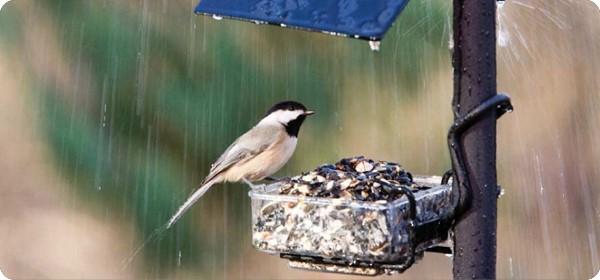Bird Behavior and Responses to Hurricane Events
As one of our family of customers and friends, you may know someone affected by the recent hurricane.
Even though our birdfeeding activity has slowed down, our hummingbirds are very active and looking for food on their southern migration. This is the perfect time to add an additional hummer feeder to your yard and help the little guys on their journey. We recommend you keep your hummer feeders out until the end of October.
Here are some basics on how birds (including hummingbirds) can react to these extreme conditions:
The storm’s high winds and extensive floodwaters have damaged numerous habitats and many of the natural food sources that are typically available for birds, particularly for ground-feeding birds that eat insects, worms and seeds. The storm also decimated countless trees and shrubs that birds use for food and shelter.
You can help birds and wildlife survive this demanding time by providing them with much needed food, fresh water and shelter.
- Birds and hurricanes have coexisted for ages, and birds have developed many strategies to survive and rebound from the effects of these natural disasters.
- Birds are sensitive to barometric pressure, so they can sense when a major storm is on the way.
- In response to an approaching hurricane, some birds will migrate earlier than they normally would. Research has found that sparrows speed up their fall departure in response to falling barometric pressures.
- Some migrating birds move toward the eye of the hurricane, staying in this calmer area until the hurricane dissipates. They often end up hundreds of miles away from their normal migration route.
- Birds that don’t migrate often shelter in place, trying to find cover wherever they can. Many non-migratory birds seek shelter inside thick bushes or on the leeward side of trees.
- Cavity roosting birds, such as woodpeckers, chickadees and nuthatches, may seek shelter in their nest or roosting cavities, and some will seek out man-made nest boxes.
- Research (although limited) seems to show that most land birds weather hurricanes well if they can find appropriate cover.
- The most direct impact of hurricanes that occur during the storm are most evident in seabirds. The indirect effects, which occur in the storm’s aftermath due to damage to the habitat, are most evident in land birds.
- Hurricanes dramatically affect birds’ natural habitat and food sources, which can put pressure on already stressed species.
- A major threat to bird survival is the vegetation damage cause by hurricanes and some birds may perish since the local habitats no longer provide the food they need.
- Due to the lack of food resources, some birds may disperse in search of more suitable habitat and others will seek out artificial sources of food.
- Migrating hummingbirds are known to swarm nectar feeders in hurricane ravaged areas where natural nectar plants have been destroyed.
- Population declines of land birds are often related to their diet and the loss of food resources. Fruit, seed and nectar feeding birds struggle the most with the loss of habit, while insect eating birds and birds of prey are less effected by the storms impact.
- Providing supplemental bird foods, fresh water and shelter are very important actions to take to help the bird population in your area after a hurricane.
As we all work to recover from this devastating hurricane, having the birds return to our backyards can bring us a sense of hope, renewal and peace. The birds will help us recover and you can help the birds recover as well.


